Australia So Much to See
Heading east to visit some outback areas in South Australia
We took the Hyden-Norseman Road to Norseman, as we have done a number of times before. It is unsealed, but usually in good condition.
Sealing has now extended to almost fifty kilometres east of Hyden.
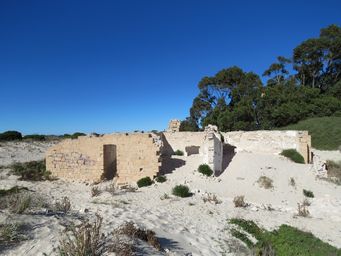
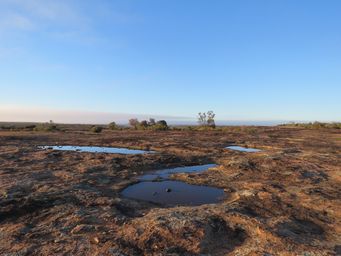
We revisited the Old Telegraph Station in the sand dunes at Eucla. There was little difference in the sand levels against this building since out previous visit fourteen years ago.
Eucla Telegraph Station ruin is an important
remnant of the largest station on the 1877 East-West Telegraph line linking Western Australia with the eastern states and overseas,
and acted as the transfer point of telegraphic messages between South Australia and Western Australia from 1898 to 1907, when the
operations were amalgamated under the WA Post and Telegraph Department.
This ruin is a remnant of the 1898 telegraph station
complex constructed at Eucla at a time when the gold finds in the State had resulted in greatly increased telegraph traffic requiring
more staff and larger station buildings, and replaced the timber telegraph station (c.1877).
This station was more than just
a telegraph station, as it served the needs of both the Government and the scattered population, with the Telegraph Master at Eyre
filling a number of roles, including Resident Magistrate, Customs Officer, Meteorological
Observer and Landing Waiter.
Eucla Telegraph
Station Ruin comprises the ruin of the limestone residence of the West Australian Telegraph Master, constructed in 1898, and small
remnants of two other buildings of the Eucla telegraph station complex, most likely the South Australian Telegraph Master's residence
and the Billiard Room (1923).
The Eucla telegraph station opened in 1877, as the main station on the East-West Telegraph line.
The Old Eucla Telegraph Station, a timber construction, was built c. 1878. New stone buildings, comprising the Telegraph Station Office
and residences for the West Australian and South Australian Telegraph Masters were constructed in 1898 to house staff and operations
during the gold boom period. The Old Eucla Telegraph Station was occupied as singlemen's quarters. After the place was abandoned by
the Government in 1927, the buildings were occupied as residence and wayside house by the Gurney family (1949-1959), who then used
much of the material in the construction of the Eucla Pass Motel (1962) and Moopina homestead (1968).
Extracts from Estate Heritage WA.
Wirrulla is called “A town with a Secret”. What is its secret? This inland rural town has a jetty! See above left
and banner at top of this page. What began as a joke became reality when opened in 2001. Most of the materials came from the
old Haslam jetty. From 1930s to 1950s wool and wheat from the area left via the Haslam jetty. All supplies also came by
sea.
We stayed at the Wirrulla caravan park, a small park. A new amenities block has one toilet and one hot shower. With only four powered sites, power it being put through the park as part of the current upgrade by the Streaky Bay Council. All this for $10 per night powered or unpowered, in a town that welcomes visitors. See details above right.
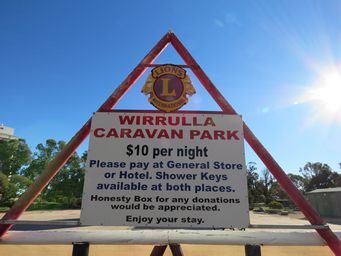
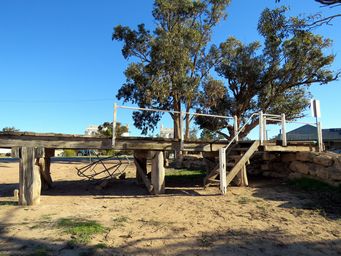
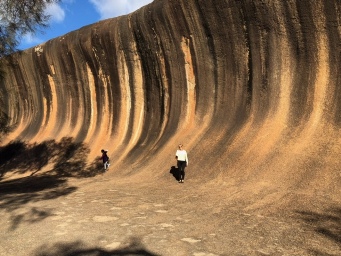
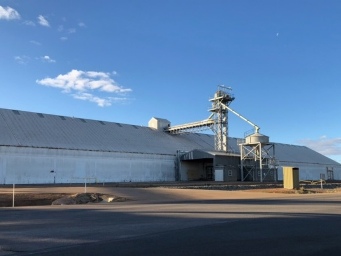
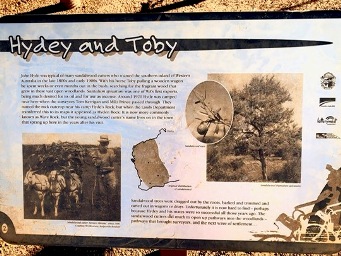
This story is outlined on the information board shown at right.
A number of novelty sculptures line the main road through Hyden where there is a rest area.
First farmers came in 1922 when the land in the area was released. The first wheat crop was grown in 1927.
A railway
between Kondinin and Hyden was built in 1930, and the Hyden townsite was surveyed in 1932. In 1933 the railway line from Lake
Grace reached Hyden.
The CBH grain bin at Hyden has a capacity of around 300,000 tonnes. Outlying bins such as East Hyden and South East Hyden are opened when needed.
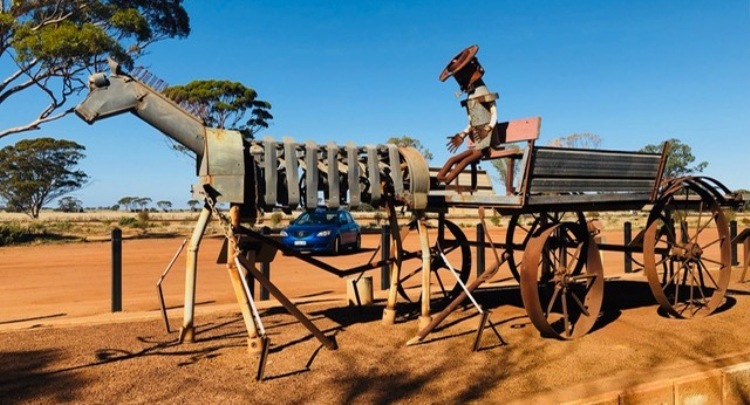
Wave Rock It is a curved granite cliff face, the northern face of a large granite erosional remnant called Hyden Rock. This curved
cliff face, resembling a wave about to break, is 15 metres high and 110 metres long. It has been rounded by weathering and water erosion,
undercutting its base and leaving a rounded overhang. Water from springs active in the wetter months runs down the cliff face, dissolving
and re-depositing chemicals in the granite, leaving red, brown, yellow and grey stains of carbonates and iron hydroxide. Its age has
been estimated at about 2700 million years. Wave Rock is around four kilometres east of Hyden townsite and now attracts over
100,000 tourists each year. While there are many rocks with wave-like faces in Western and South Australia, Wave Rock has the
longest unbroken span.
On the eastern end of Hyden Rock, Hippo’s Yawn consists of an unusually shaped granite tor that was formerly part of the larger outcrop.
It is connected to Wave Rock and the car park by a loop walking track approximately one kilometre long, or you can drive.
The
Hyden Water Supply Dam and Catchment utilizes low rock walls around most of Hyden Rock to capture and divert rainwater into the dam. The dam was constructed in 1928 with a capacity of 3,380 cubic metres, and was extended in 1951 to a capacity of 29,810 cubic metres
to supply water to the town of Hyden. The total catchment area on Hyden Rock is 29.3 hectares. In 2000 Hyden was connected to
the Western Australian Water Corporation's Comprehensive Water Supply Scheme, but the water from the dam is still highly valued particularly
during times of water restrictions.
There is a caravan park at the rock face.
Resources
Hyden Walk Trails printable brochure
The Wildlife Park in three hectares of natural bushland creates a beautiful haven for the native
and exotic animals and birds that live at the Wave Rock Wildlife Park. Don’t miss the white, grey or silver kangaroos and wallabies,
koalas, golden possums, deer, donkeys, alpacas, camels, exotic poultry, water birds, swans, owls, betongs, wombats and many more.
The
Lace Place Museum was built in 1990 to house the Blackburn Collection. Mrs Margaret Blackburn OAM JP of Perth (1920 -1990) had a keen
interest in history and lace. To her own inherited family collection, she added pieces from Australia and overseas and was able to
incorporate several smaller collections.
The Miniature Soldier Museum. This amazing collection of over 10,000 handmade
pieces created by Alex Smith are displayed in series of the great wars. See soldiers at war in jungles and deserts and the six metre
long display of the 1953 Coronation of Queen Elizabeth II. See soldiers at battle in jungles and deserts with miniature tanks
and guns. This amazing display includes the Napoleonic War, the American Civil War, the Zulu War, the Pacific War, the Russian War,
World War 1 and World War 2.
Close to the saline Lake Magic, around two kilometres by road from Wave Rock, Denis Collins constructed a twenty metre round, six metre deep swimming pool-like gypsum pond whose buoyancy and therapeutic properties are greater than those of the Dead Sea. There is a resort with villas at Lake Magic.
While in the area you can also visit The Humps and Mulkas Cave. The Humps are located around twenty kilometres north of Hyden
via the road to Marvel Loch and Southern Cross. The Humps is an impressive granite formation which rises about eighty metres
above the surrounding countryside. It is best known for Mulka's Cave. Mulka's Cave (which was sometimes known as Bates Cave)
is named from the following Aboriginal dreamtime legend and Aboriginal rock painting and hand prints. There are over 450 hand
prints and paintings in the cave.
A charrnok, a giant evil spirit, called Mulkin-Jal-la (Mulka the Terrible) lived in the cave, which was named Mulkas Cave.
Mulka's
mother had been falling in love with a warrior from a forbidden tribe. Her child from this forbidden relation was a devil child who
became known as Mulkin-Jal-la. Mulka became known throughout the area as a murderer and a cannibal. He lived in this cave and left
the imprints of his hands on the walls.
When his mother chided him for eating children, he killed her. Finally he was hunted
down and killed by the tribe near Dumbleyung.
The whole area was then declared taboo, and the early settlers saw no evidence
of recent inhabitation when they first arrived.